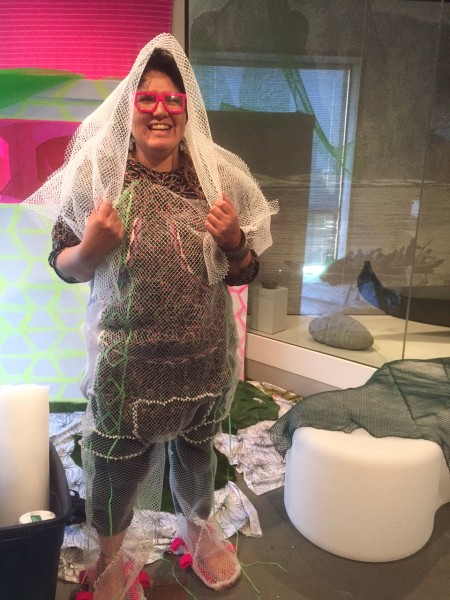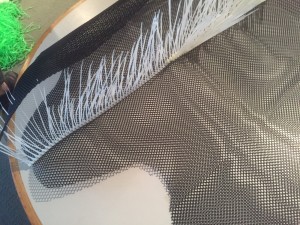
How do you connect with the past and the future at the same time? For one artist, the start is through polar bear hides made of zip ties and an ancient Inupiaq whaling suit made of flexible plastic mesh. Allison Warden speaks about her newest project, The Place of the Future-Ancient.
Sitting in the Alaska Gallery at the Anchorage Museum, surrounded by historical images and dioramas, a volunteer pulls translucent zip ties through heavy black plastic mesh. The zipping repeats over and over as he methodically covers every intersection.

The plastic is meant for covering crab pots, but artist Warden has cut it into the shape of a polar bear hide. At this stage, the three long rows of ties make it look like a punk rock skunk fur. It will take about 360 hours–eight solid work weeks–to complete the task. Warden says the process reflects the work of her Inupiat ancestors.
“We did have a lot of crafts and different things that we created that have a similar tedious nature to it, where you’re just doing the same motion. Very repetitive, meditative motion to create something that you need for your survival and your life.”
But the object itself refers to the future. “The deeper reflection as you see a plastic polar bear hide is a reflection of the state of the polar bear today and what it might be in 50 years.”
And beyond. Well beyond, into what Warden calls the Hyper-Future. She plans to make three more hides with the same arduous process. She’s also using zip ties to hold together a full-body whaling suit, modeled after those used by her ancestors.
“We would be able to butcher whales half submerged in the ocean in these scuba suits,” she explains. “And it would be waterproof and watertight up to your face. So you would basically be submerged up to your chest.”
But Warden’s modernizing the materials, in part because working with bearded seal skin is difficult, especially in the middle of the museum where she’s demonstrating her craft. She also doesn’t want to wear a hot skin suit for two months solid when performing in her upcoming show, Unipkaagusiksuguvik: The Place of the Future-Ancient.
She says to imagine that time isn’t a line, it’s a circle. And in the place where the far future connects with the ancient past is an Inupiat ceremonial house filled with ancient objects made of modern materials, like neon paints and glow in the dark beads. That’s where Warden’s identity lives — connected to her past but also to her future.
“It’s the place where myths are born. It’s the birth place of the old, old stories.”
And it’s a place of language. For the two-month-long exhibit, Warden will only speak Inupiat. She says she’s always wanted to be proficient and this project gives her a two-year deadline.
Visitors won’t understand her words necessarily, but they will be able to communicate through body language, expressions, and art– things that transcends the past, the future, and the mythical space in between.
Warden’s show opens in October of 2016. She’s currently creating the pieces as a demonstration in the Anchorage Museum through 6 pm on Friday. She’ll return next summer as well.
Anne Hillman is the healthy communities editor at Alaska Public Media and a host of Hometown, Alaska. Reach her at ahillman@alaskapublic.org. Read more about Anne here.





